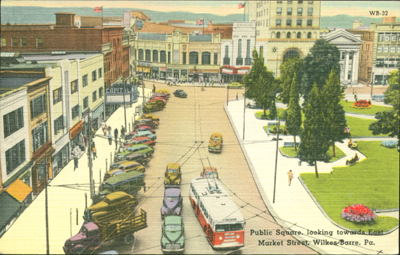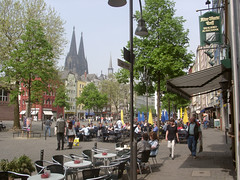A bit on "New Suburbanism" and "Manchurian" Main Streets
I consider myself a "new urbanist" although I am in the "old urbanist" division, and I focus on the revitalization and repopulation of the center cities. I was at a Project for Public Places workshop last week and Fred Kent, in his presentation, called "New Urbanism" "New Suburbanism" because as he said, it is really about making better suburbs. I know that this will attract some negative response, and new urbanists always point out infill projects, but the fact is, these massive developments in the suburbs (Kentlands in Gaithersburg, Norton Commons on the border of Jefferson and Earlham counties--Louisville--Kentucky, etc.) are but another salvo in decentralization and dispersal of development away from a region's core.
On the pro-urb email list over the last week there has been a spirited discussion in response to the article "Manchurian Main Street: Are shopping districts inspired by New Urbanism a form of cultural brainwashing?," in the June issue of Metropolis Magazine. The article criticized the construction of lifestyle centers as "faux" Main Streets, with manufactured ersatz old signs, etc., as inauthentic.
 A bit of "Manchuria" at Bowie Town Center in Prince George's County, Maryland.
A bit of "Manchuria" at Bowie Town Center in Prince George's County, Maryland.I agree and here's some stuff I've written about it. In response to a post that called the article "pseudo-intellectual" b.s.:
How do you address the issue of authenticity versus the exchange value of place, and the continued disinvestment and "de-accessioning" of traditional, extant commercial districts, and the lack of comfortability with diversity, which leads people uncomfortable with people different from themselves to seek similar experiences in more homogeneous (certainly by socioeconomic status, to some extent by race) settings that tend to be constructed experiences by one developer?
Maybe the article was crap, but the problems identified are not.
And then I wrote:
Although it might be obscure, I use the term "de-accessioning" which is a term used by libraries, to refer to events such as the closing of inner city schools while new schools are being built in the suburbs, etc. Parts of cities have always been successful (well maybe not so much in cities like Detroit) even though people have preferred the suburbs especially since the end of WWII.
The marginal increase in demand for urban living in recent years has been driven by a number of factors, and maybe the rise of new urbanism is one of them, although I don't think so. In DC, it comes from the strong employment engine of the federal government, a good public transportation system, historic residential building stock, and a classic urban design.
Jim Meyers of the Responsible Hospitality Institute makes a good presentation that in part it this demand for urban living has been driven by the rise of pro-city tv programs like Seinfeld and Friends as opposed to 50s, 60s, and 70s tv shows like The Nelsons, Father Knows Best, Ozzie and Harriet, and the Brady Bunch. Seinfeld and Friends are very urban shows without the "new". It doesn't hurt that an increasing number of people don't like commuting.
The point about the exchange value of place is that most developers could care less about urbanism, new or old, they just want to make money from it. "Lifestyle" centers are the flavor of the moment, so that's what's being built.
The point about continuing to build new, rather than re-invest in the old when it is a realistic option, is a perennial problem in the U.S. It continues to enable sprawl.
So in Prince Georges County you have disinvested strip retail along Rt. 1, or disinvested inner-suburbs, and you build Bowie Town Center, the Boulevard at Capital Centre where the old basketball arena was, etc. (see http://www.johnsondevelopmentcorp.com/newmall.html). It is new urbanism at the expense of old urbanism.
Or in DC, if we don't make good planning decisions then we get our clocks cleaned by Montgomery or Arlington Counties (i.e., Bethesda Row, Silver Theatre in Monto, and Pentagon Row, Clarendon etc. in Arlington).
I do see living in the suburbs in part a fleeing of having to deal with persistent urban problems (clean, safe, poverty), and the farther away from the center city one lives, such feelings tend to be more pronounced and expressed (i.e., the husband of my boss telling me at a work holiday party that he didn't understand how a thinking person--it was the Barry years--could live in DC [they live in Gaithersburg] and I merely replied, "It takes me 15 minutes to get to work [deliberate pause] by bike).
Cleveland is a good example. I don't know what a build-out analysis of the city would say, but I can see it accomodating a few hundred thousand "new" residents, merely replacing those that left. So every Crocker Center makes that much harder. It goes back to the idea of compact development and infill as a sustainable land use and resource planning practice. Same thing with Detroit. For every lifestyle center 25 miles away from Detroit, well, you what about the 55 square miles of empty land in the City of Detroit, etc.
Again, without urban growth boundaries recentering and to some extent intensifying land use, I can't see this happening. This is where I bring up the phrase "smarter spawl" and exit left.I agree with Seth that it's important to build great "urbanism" into new developments, but it doesn't come without costs to other parts of the region in which it is built. Maybe that's my role as an advocate for the center cities.
And finally:
"Main Streets" "Shopping Streets" "High Streets" that are "authentic" are (1) a part of the everyday physical building fabric of communities, (2) often not requiring special shopping trips to get to from some great distance from home, and (3) have more than just retail businesses-- including service businesses, offices (medical, dental, etc.), government services (libraries, post offices, etc.), and nonprofit organization representation, including, at times, churches, even light industrial and housing.
 Old postcard showing the town square in Wilkes-Barre Pennsylvania.
Old postcard showing the town square in Wilkes-Barre Pennsylvania.Examples are places like the stores at the corner of 4th or 5th and East Capitol, which are across the street (or next to) a used bookstore, a dry cleaner, etc. Others are streets like Pennsylvania Avenue SE where there are a bunch of restaurants, coffee shops, banks, a post office, other stores and offices, etc.
An example of a place created pretty much to make $ would be something like Pentagon Row in Arlington. Granted that there is housing there and the retail serves the residents, I imagine that most patrons make subway or car trips to get there, and I would be interested to see what the distance is for the trips to get there.
I really embrace the distinction that Logan and Molotch make over "the use value of place versus the exchange value of place."
True Main Streets mingle the use value and the exchange value of place in substantive ways. The point you make about a "public place" is important, but that's not merely a function of being old or not, it's a function of the "functions," business _and_ other that are present there.
 We still have a bit to learn from Europe. Photo of Cologne, Germany, by BERNARD E. DROEGE.
We still have a bit to learn from Europe. Photo of Cologne, Germany, by BERNARD E. DROEGE.



0 Comments:
Post a Comment
<< Home